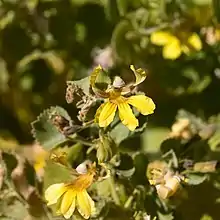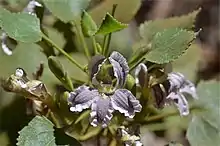Goodenia grandiflora
Goodenia grandiflora, commonly known as large-flowered goodenia,[2] pinnate goodenia or mountain primrose,[3] is a species of flowering plant in the family Goodeniaceae and is endemic to Australia. It is an erect under-shrub with toothed, egg-shaped to round leaves and racemes or thyrses of yellow, white or purplish flowers.
| Large-flowered goodenia | |
|---|---|
 | |
| Goodenia grandiflora at Mount Isa | |
| Scientific classification | |
| Kingdom: | Plantae |
| Clade: | Tracheophytes |
| Clade: | Angiosperms |
| Clade: | Eudicots |
| Clade: | Asterids |
| Order: | Asterales |
| Family: | Goodeniaceae |
| Genus: | Goodenia |
| Species: | G. grandiflora |
| Binomial name | |
| Goodenia grandiflora | |
| Synonyms[1] | |

Description
Goodenia grandiflora is an erect under-shrub that typically grows to a height of 1.5 m (4 ft 11 in) with sticky, hairy foliage. The leaves have an egg-shaped to rounded lamina 25–50 mm (0.98–1.97 in) long and up to 60 mm (2.4 in) wide on a petiole up to 50 mm (2.0 in) long, the edges of the leaves toothed and the base heart-shaped. The flowers are arranged in racemes or thyrses up to 250 mm (9.8 in) long on a peduncle up to 3 mm (0.12 in) long with leaf-like bracts at the base. Each flower is on a pedicel up to 50 mm (2.0 in) long with linear bracteoles up to 4 mm (0.16 in) long. The sepals are lance-shaped, up to 6 mm (0.24 in) long and the petals are yellow, white or purple and up to 23 mm (0.91 in) long. The lower lobes of the corolla are 8–9 mm (0.31–0.35 in) long with wings about 3 mm (0.12 in) wide. Flowering occurs in most months but mainly from May to November and the fruit is an oval capsule 10–13 mm (0.39–0.51 in) long.[2][3][4][5]
Taxonomy and naming
Goodenia grandiflora was first formally described in 1805 by John Sims in the Botanical Magazine.[6][7] The specific epithet (grandiflora) means "large-flowered".[8]
Distribution and habitat
This goodenia grows in rocky places on hills in the Northern Territory, Queensland and eastern New South Wales.[2][3][4]
Conservation status
Goodenia grandiflora is classified as "Priority One" by the Government of Western Australia Department of Parks and Wildlife, meaning that it is known from only one or a few locations which are potentially at risk, but as of "least concern" in the Northern Territory and Queensland.[3][5][9][10]
References
- "Goodenia grandiflora". Australian Plant Census. Retrieved 3 February 2021.
- Carolin, Roger C. "Goodenia grandiflora". Royal Botanic Garden Sydney. Retrieved 3 February 2021.
- "Goodenia grandiflora". Northern Territory Government. Retrieved 3 February 2021.
- Carolin, Roger C. "Goodenia grandiflora". Australian Biological Resources Study, Department of Agriculture, Water and the Environment: Canberra. Retrieved 3 February 2021.
- "Goodenia grandiflora". FloraBase. Western Australian Government Department of Parks and Wildlife.
- "Goodenia grandiflora". APNI. Retrieved 3 February 2021.
- Sims, John (1805). "Goodenia grandiflora". Curtis's Botanical Magazine: 890. Retrieved 3 February 2021.
- Sharr, Francis Aubi; George, Alex (2019). Western Australian Plant Names and Their Meanings (3rd ed.). Kardinya, WA: Four Gables Press. p. 210. ISBN 9780958034180.
- "Conservation codes for Western Australian Flora and Fauna" (PDF). Government of Western Australia Department of Parks and Wildlife. Retrieved 16 December 2015.
- "Species profile—Goodenia grandiflora". Queensland Government Department of Environment and Science. Retrieved 3 February 2021.